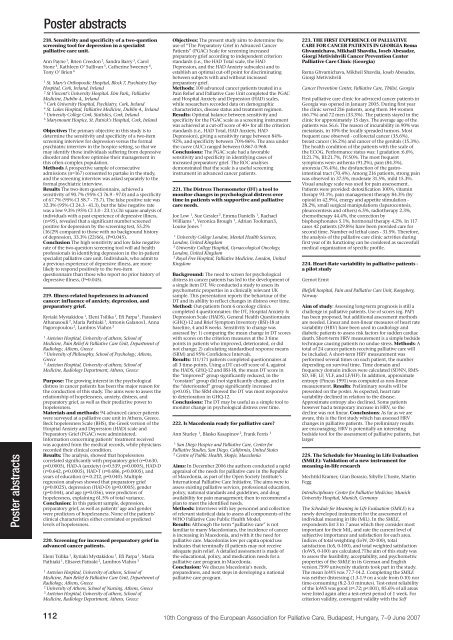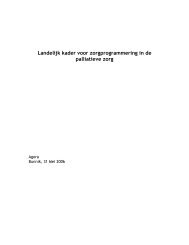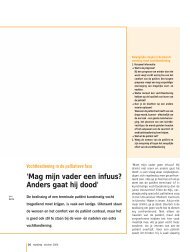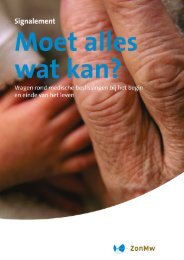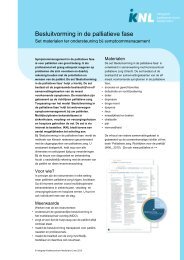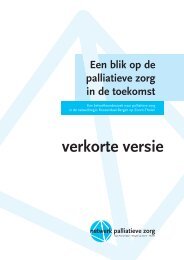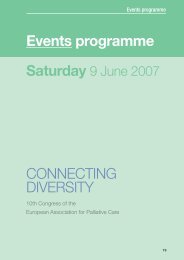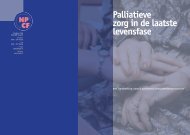Poster abstracts CONNECTING DIVERSITY
Poster abstracts CONNECTING DIVERSITY
Poster abstracts CONNECTING DIVERSITY
Create successful ePaper yourself
Turn your PDF publications into a flip-book with our unique Google optimized e-Paper software.
<strong>Poster</strong> <strong>abstracts</strong><br />
<strong>Poster</strong> <strong>abstracts</strong><br />
218. Sensitivity and specificity of a two-question<br />
screening tool for depression in a specialist<br />
palliative care unit.<br />
Ann Payne 1 , Brien Creedon 2 , Sandra Barry 3 , Carol<br />
Stone 4 , Kathleen O’ Sullivan 5 , Catherine Sweeney 6 ,<br />
Tony O’ Brien 6<br />
1<br />
St. Mary’s Orthopoedic Hospital, Block 7, Psychiatry Day<br />
Hospital, Cork, Ireland, Ireland<br />
2<br />
St Vincent’s University Hospital. Elm Park,, Palliative<br />
Medicine, Dublin 4., Ireland<br />
3<br />
Cork University Hospital, Psychiatry, Cork, Ireland<br />
4<br />
St. Lukes Hospital, Palliative Medicine, Dublin 4., Ireland<br />
5<br />
University College Cork, Statistics, Cork, Ireland<br />
6<br />
Marymount Hospice, St. Patrick’s Hospital, Cork, Ireland<br />
Objectives The primary objective in this study is to<br />
determine the sensitivity and specificity of a two-item<br />
screening interview for depression versus the formal<br />
psychiatric interview in the hospice setting, so that we<br />
may identify those individuals suffering from depressive<br />
disorder and therefore optimise their management in<br />
this often-complex population.<br />
Methods A prospective sample of consecutive<br />
admissions (n=167) consented to partake in the study,<br />
and the screening interview was asked separately to the<br />
formal psychiatric interview.<br />
Results The two-item questionnaire, achieved a<br />
sensitivity of 90.7% (95% CI 76.9 - 97.0) and a specificity<br />
of 67.7% (95% CI 58.7 - 75.7). The false positive rate was<br />
32.3% (95% CI 24.3 - 41.3), but the false negative rate<br />
was a low 9.3% (95% CI 3.0 - 23.1).Chi square analysis of<br />
individuals with a past experience of depressive illness,<br />
(n=95), revealed that a significant number screened<br />
positive for depression by the screening test, 55.2%<br />
(16/29) compared to those with no background history<br />
of depression, 33.3% (22/66), (P=0.045).<br />
Conclusion The high sensitivity and low false negative<br />
rate of the two-question screening tool will aid health<br />
professionals in identifying depression in the in-patient<br />
specialist palliative care unit. Individuals, who admit to<br />
a previous experience of depressive illness, are more<br />
likely to respond positively to the two-item<br />
questionnaire than those who report no prior history of<br />
depressive illness, (P=0.045).<br />
219. Illness-related hopelessness in advanced<br />
cancer: influence of anxiety, depression, and<br />
preparatory grief.<br />
Kyriaki Mystakidou 1 , Eleni Tsilika 1 , Efi Parpa 1 , Paraskevi<br />
Athanasouli 2 , Maria Pathiaki 1 , Antonis Galanos1, Anna<br />
Pagoropoulou 2 , Lambros Vlahos 3<br />
1<br />
Areteion Hospital, University of athens, School of<br />
Medicine, Pain Relief & Palliative Care Unit, Department of<br />
Radiology, Athens, Greece<br />
2<br />
University of Philosophy, School of Psychology, Athens,<br />
Greece<br />
3<br />
Areteion Hospital, University of athens, School of<br />
Medicine, Radiology Department, Athens, Greece<br />
Purpose: The growing interest in the psychological<br />
distress in cancer patients has been the major reason for<br />
the conduction of this study. The aims were to assess the<br />
relationship of hopelessness, anxiety, distress, and<br />
preparatory grief, as well as their predictive power to<br />
hopelessness.<br />
Materials and methods: 94 advanced cancer patients<br />
were surveyed at a palliative care unit in Athens, Greece.<br />
Beck hopelessness Scale (BHS), the Greek version of the<br />
Hospital Anxiety and Depression (HAD) scale and<br />
Preparatory Grief (PGAC) were administered.<br />
Information concerning patients’ treatment received<br />
was acquired from the medical records, while physicians<br />
recorded their clinical condition.<br />
Results: The analysis, showed that hopelessness<br />
correlated significantly with preparatory grief (r=0.630,<br />
p


